Did you know that your uterus weighs around 40 g?
And that the average weight of the bladder is 32 g? [1],[2]
These numbers make you think: WOW! These organs are really light.
But…
Did you know that –– in case of pregnancy –– the weight of the uterus increases to 1000g or more!
While the bladder can normally carry 500-700ml of urine when it is full. [1], [3]
Also, the pressure inside your belly increases normally during breathing, coughing, sneezing and straining or simply after a heavy meal.
Well..
These organs can get really heavy sometimes!
And they definitely need some support.
This is when your pelvic floor comes into play.
Keep tuned to learn more about your pelvic floor, and the best poses of yoga for pelvic pain and yoga for endometriosis.
What is Pelvic Floor?
At the bottom of your pelvis, there is a hammock-like combination of muscles and ligaments known as the Levator Ani muscles or the pelvic floor. [4]
These muscles carry the weight of your internal organs such as the uterus, vagina and the bladder. [4], [5]
In addition, the pelvic floor contracts all the time to prevent urine from skipping, and it relaxes occasionally to allow voiding. [5],[6]
It also plays a similarly important role in:

- Controlling the process of defecation (passing stool)
- Maintaining a proper position of the pelvis
- Maintaining proper alignment and posture
- Maintaining core stability with the diaphragm and abdominal muscles [6]
For this reason, it is important to pay special attention to your pelvic floor muscles and ensure that you keep them in order.
Say goodbye to the old and outdated Kegel’s exercises and say hello to new programmes of yoga for pelvic pain and even yoga for endometriosis.
- If you have pelvic pain or uncomfortable time in bed with your partner.
- Or embarrassing leakage when you laugh or sneeze, and if the exercises you received are not working for you.
It is the right time to implement the best yoga for pelvic floor exercises to root out pelvis dysfunction!
- Mais will help you pack all pelvic floor yoga benefits in one programme made specially for you.
- Contact Mais Talie now !
Hypertonic & Hypotonic Pelvic Floor Explained
Did you know that pelvic floor dysfunction is just a wide umbrella that lays shadow on different types of pelvic problems?
Each pelvic problem results in specific symptoms, and thus requires a specific yoga for pelvic floor programme.
Based on these facts, it is important to find out whether your pelvic floor is hypo – or hypertonic. [7], [8]
What is a Hypertonic Pelvic Floor?
Hypertonicity (increased tone) of the pelvis is also known as pelvic floor spasm, non-relaxing pelvic floor and pelvic floor overactivity. [7]
There are several reasons behind an overactive pelvic floor.
But the most common non-neurogenic causes include:
- Pelvic surgery,
- Vaginal delivery,
- Injury to your back or pelvis,
- If you have an abnormal walking pattern (e.g., from a flat foot)
- Chronic pelvic pain,
- History of sexual abuse,
- Chronic emotional stress
- Frequently holding oneself to inhibit micturition. [7]
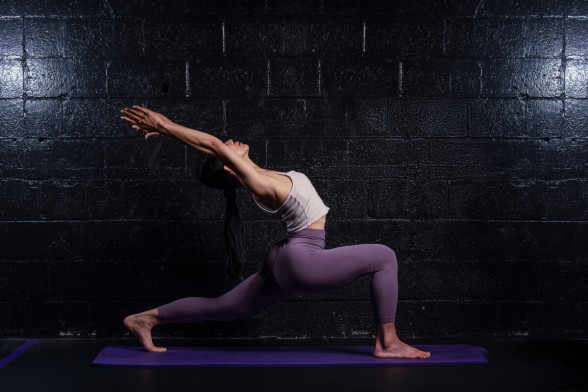
So, what are the Symptoms of a Spasmed Pelvic Floor?
When your pelvic muscles are spasmed, they result in a number of symptoms that are different from a hypotonic pelvic floor.
The most common symptoms are:
- Pelvic pain that refers to other areas such as the abdomen, thighs or the buttocks.
- Problems with sexual arousing and satisfaction.
- Urge incontinence
- Pelvic heaviness [7]
Hypotonic Pelvic Floor: What is the difference?
Unlike hypertonic pelvic muscles, hypotonicity of the pelvic floor means your muscles are too weak and are unable to support your pelvic organs.
As a result, you may notice one or more of the following symptoms:
- Leakage of urine when you cough, sneeze or laugh. (i.e., stress incontinence)
- Dysfunction in micturition and defecation
- Organ prolapses (e.g., vaginal, rectal)
- Sexual dysfunction [8]
Did you know that these symptoms are directly caused by hypotonicity of your pelvic floor?
Yet, you may notice indirectly-related symptoms such as pelvic pain, low back pain and abnormal posture. [8],[6]
This type of weak pelvic floor requires customised yoga for pelvic floor strength programme in addition to laser sharp lifestyle modifications.
These two will help you relieve the pressure on your pelvic floor.
- Still unable to decide whether you have weak or tight pelvic floor muscles?
The best London expert in teaching yoga for pelvic pain Mais Talie will help you understand your problems and create the best customised solutions for you.
Seven Yoga Poses to Restore Your Pelvic Health
Because you are special, you deserve a special rehabilitation programme that harnesses all pelvic floor yoga benefits and helps you connect to the deeper parts of your body.
That’s right, there are a countless number of asanas in yoga for pelvic pain.

These yoga asanas can help you:
- Restore the balance of your pelvic floor
- Balance the tone of your Levator Ani muscles
- Reduce low back pain
- Correct the position of your pelvis
- Strengthen your pelvic floor
- Prevent organ prolapse and
- Improve your posture. [9], [10]
The Best 7 Yoga Poses for Pelvic Floor
If you are having a tight pelvic floor, it is better to focus on poses that encourage you to breathe, relax and stretch your pelvic floor muscles while holding the position for a longer period of time.
This will release the tension and will help the tight muscles relax and let go.
Get your mat ready, and try the following poses of yoga for pelvic pain:
1- Half-Happy Baby Pose
Lie down on your mat with your back and head supported with rolled towels, plant one foot on the ground and pull the other leg towards your chest.
Reach with your opposite hands and catch your bent leg by the foot, hold your heel just like a happy baby holds his foot.
Feel the stretch in your sitting bone as you breathe in deeply and try to push your sitting bone further away from your body to increase the stretch.
Close your eyes and feel the tension leaving your body with every breath.
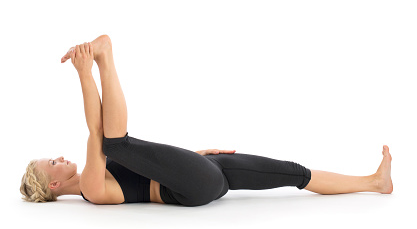
2- Reclining Figure Four Pose
From the same position on your mat, plant one foot on the ground and put your right heel on your left knee so that your legs are crossed like a “figure 4”.
With your interlaced fingers, hold the left leg just above the knee, and pull your leg towards your chest.
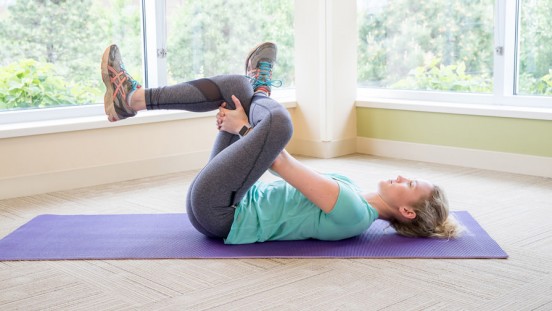
As you hold this position, feel the stretch deep in your hip bone.
Breathe in deeply, then out slowly and feel the tension leaving your body with every breath.
Hold this position for 1-3 minutes and switch sides.
3- Reclining Bound Angle Pose
One of the most relaxing asanas in yoga for pelvic floor. This pose could leave you with zero tension in your pelvic floor!
Simply lie down on your mat with rolled towels under your head and back.
Rest your arms on both sides with your palms facing upward.
Put your feet together with your knees bent.
Slowly separate your legs with your feet still touching.
Lower your bent knees towards the floor until your knees touch the ground on each side.
If you are not there yet, Don’t worry! Just let the gravity stretch your inner thighs and hips and your flexibility will improve as you repeat the pose.
Make sure to breathe in deeply and out slowly to release all the tension in your body and pelvic floor.
Hold this position for 5 minutes.
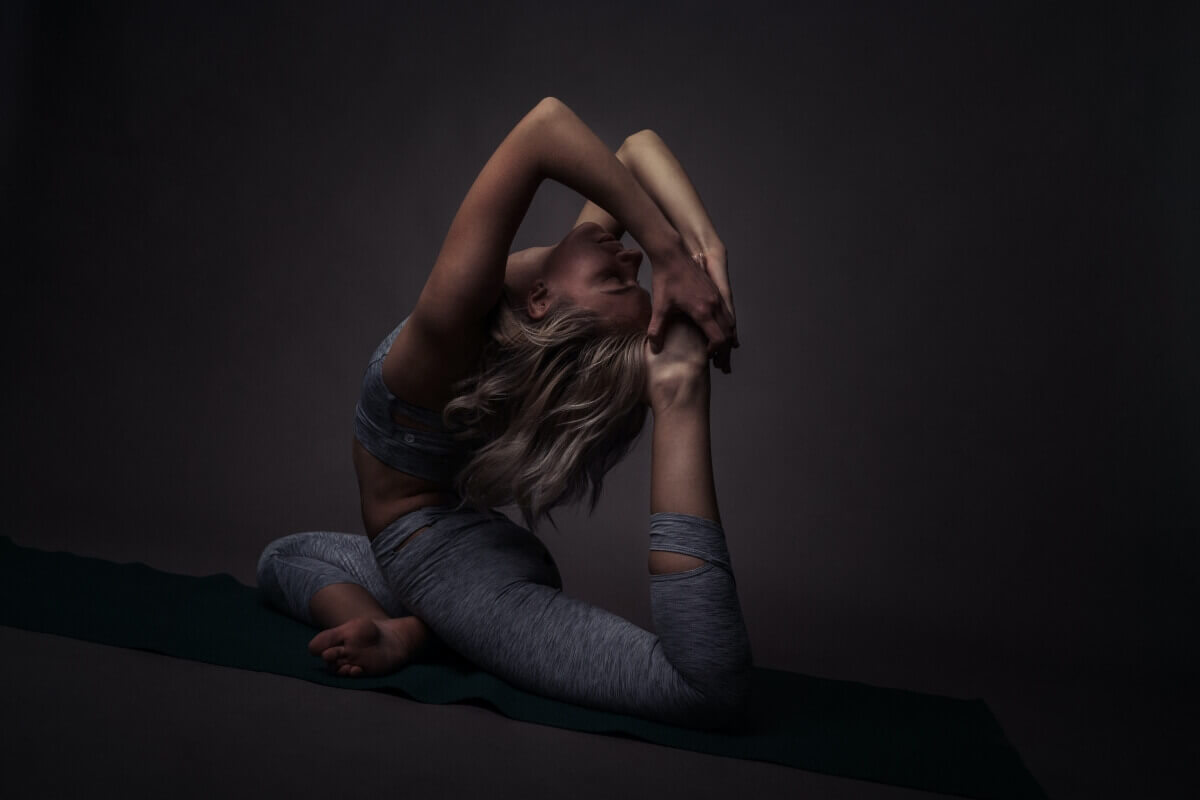
Do you want to know how yoga for pelvic pain can help you eliminate your pelvic pain?
Apply now for a FREE CONSULTATION.
On the contrary…
If your pelvic floor muscles are weak, and you are struggling with incontinence, low back pain or poor posture
or if you have recently given birth and would like to restore your pelvic strength, here are some yoga poses for you:
4- The Mountain Pose with Block
Although this pose seems easy, it will take you some serious work to get it right.
Simply stand tall with your feet slightly apart, place a block or a ball between your thighs and feel the weight of your body falling on your heels.
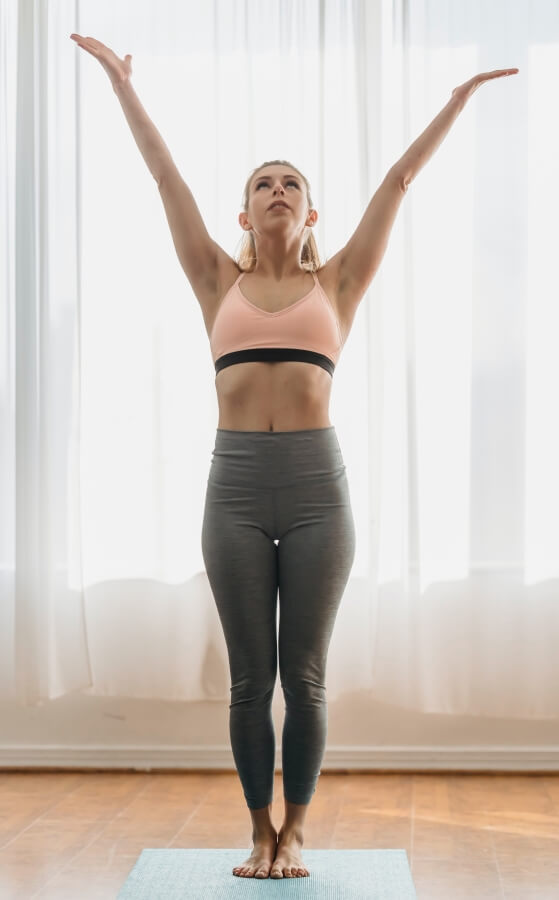
Pull your quads and kneecaps up, tighten your glutes, tuck your tummy in, pull your shoulder blades and squeeze them, tuck your chin in and keep your spine erect.
Rotate your arms so that your palms face forward.
When you assume the pose, feel the tension in your muscles, and when you feel confident enough, breathe in deeply while squeezing the block between your legs.
Release the squeeze just a little while exhaling slowly.
Repeat and maintain the pose for 1-5 minutes.
To make this pose harder, keep your muscles tight and reach your arms up high.
5- Block and Chair Pose
If the mountain pose is easy for you, take it to the next level by bringing a chair behind you.
From the same standing position as the mountain pose with the block between your thighs, stand in front of a chair, keep your spine straight and bend your knees and hips as if you were about to sit on the chair.
Keep distance between your hips and the chair, tuck your tummy in and squeeze the block between your thighs.
Hold this pose and feel the tension in your pelvic floor muscles as they get activated.
Breathe in and out and hold this pose for 1-5 minutes.
If you want to make this pose even harder, try reaching up with your arms or try to balance on your toes.
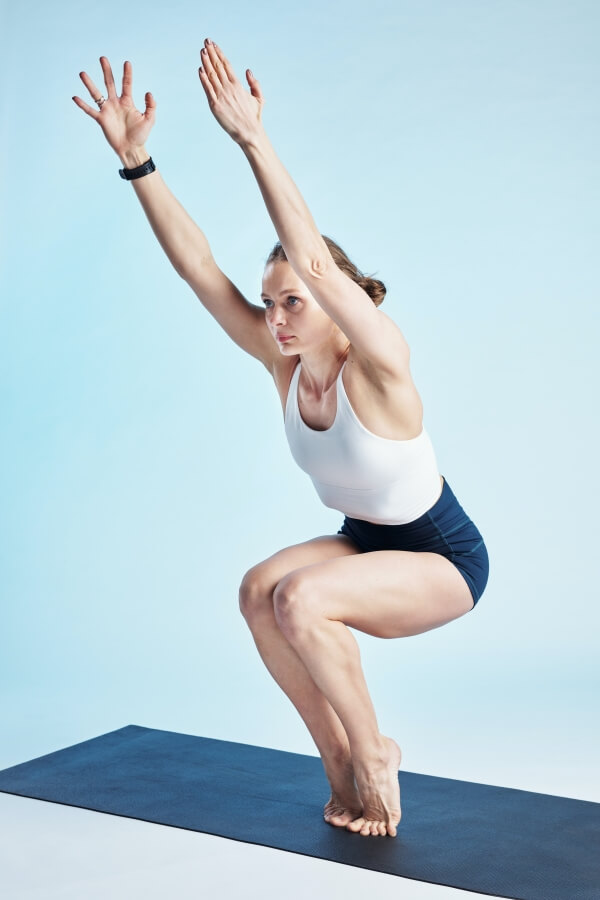
6- Plank Pose
Plank pose is one of the best yoga for pelvic floor poses to build your abdominal and pelvic-floor strength.
Place your elbows and feet on the mat, and lift your hips so that your hips and spine are in line with each other.
Tuck your tummy in, tighten your glutes and leg muscles.
Feel the tension travelling to your muscles including your pelvic floor muscles.
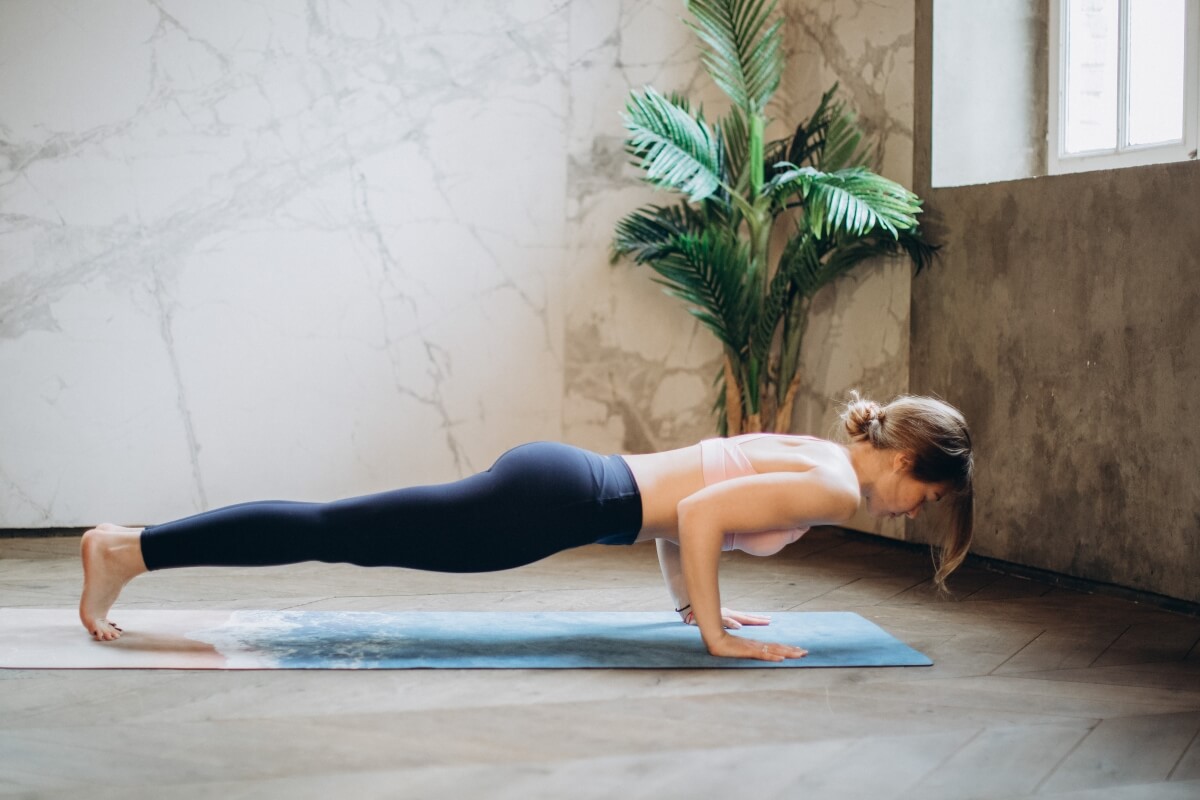
Breathe in deeply and think of this breath delivering oxygen to your muscles allowing them to contract and get stronger.
Exhale slowly and focus on maintaining your pose while exhaling.
When this pose becomes easy for you, you can challenge your muscles by doing the same pose on your hands instead of your elbows.
7- Cat-Cow Pose
If you have a combination of hypo and hypertonic pelvic problems, this yoga pose is the one for you.
Come on hands and knees with a towel under your knees, arch your back as low as you can moving into the cow-pose.
Breathing in deeply, then out slowly.
After that, assume the cat-pose by arching the back up high and tucking your tummy in towards your spine.
Do not forget to breathe in and out as you hold these positions, repeat each position 5-7 times.
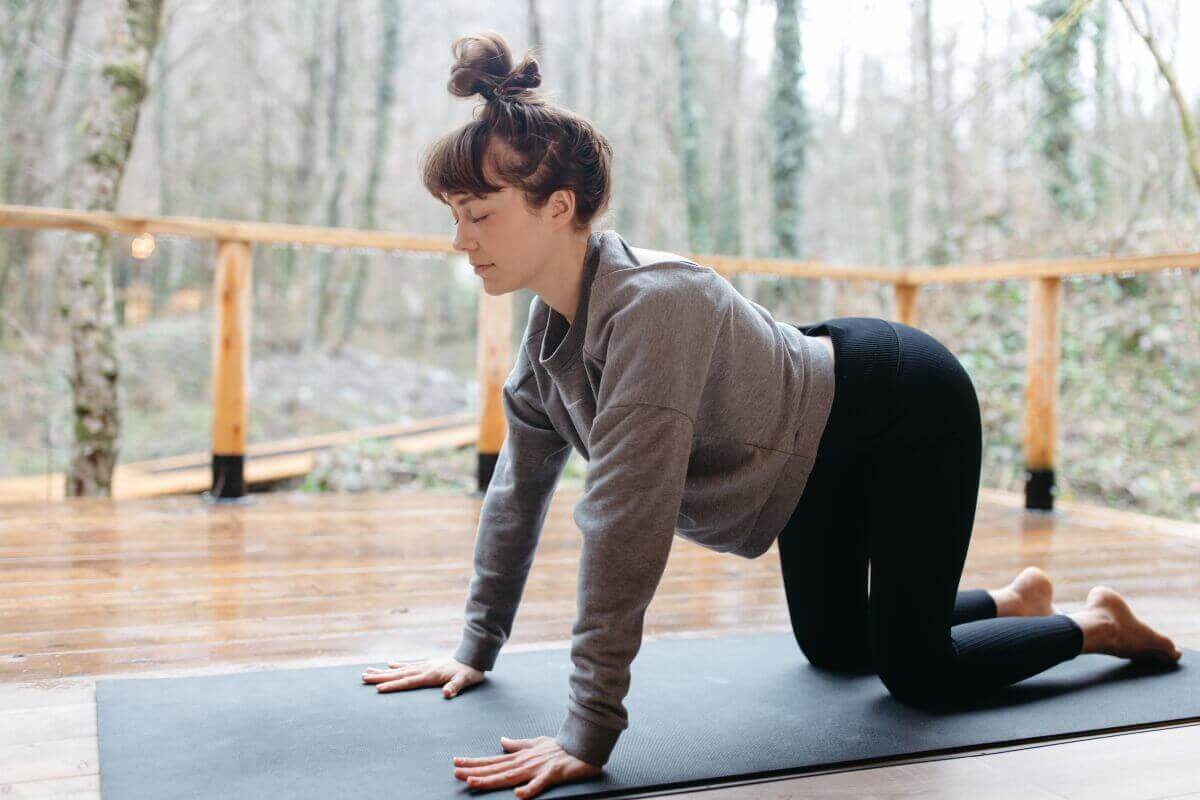
Want to Prevent Bladder Leakage?
Enjoy Beautiful Yoga Feelings working directly with Mais
It’s stressful for women to be suffering from bladder issues.
In addition, women usually find it embarrassing to discuss “down-there” problems with experts.
But, how about seeking help from a female expert who understands all your fears and concerns.
That’s right.
Not only will Mais Talie listen to your smallest details, but also will help you understand the nature of your problem, and will design you an effective yoga for pelvic floor programme to restore your pelvic health once and for all.
REFERENCES
1. Magowan, B., In Owen, P., & In Thomson, A. J. (2014). Clinical obstetrics & gynaecology.
https://eu-ireland-custom-media-prod.s3-eu-west-1.amazonaws.com/UKMEAEU/eSample/9780702074042-sample-chapter.pdf
2. Al-Shaikh, Ghadeer & Al-mandeel, Hazem. (2012). Ultrasound Estimated Bladder Weight in Asymptomatic Adult Females. Urology journal. 9. 586-91.
https://www.researchgate.net/publication/230698386_Ultrasound_Estimated_Bladder_Weight_in_Asymptomatic_Adult_Females
3. InformedHealth.org [Internet]. Cologne, Germany: Institute for Quality and Efficiency in Health Care (IQWiG); 2006-. How does the urinary system work? 2009 Nov 25 [Updated 2018 Apr 5]. Available from:
https://www.ncbi.nlm.nih.gov/books/NBK279384/
4. Marlene M. Corton (20019): Anatomy of Pelvic Floor Dysfunction. doi:10.1016/j.ogc.2009.09.002
https://drcapmartin.com/sites/default/files/Anatomi%CC%81a%20del%20Piso%20Pe%CC%81lvico.pdf
5. Varuna Raizada, MD, Ravinder K. Mittal (2008): Pelvic Floor Anatomy
and Applied Physiology
https://www.ics.org/Workshops/HandoutFiles/000104.pdf
6. Abigail Scheer (2013): A Literature Review How the Stability of the Pelvic Floor Complex Affects the Lumbar Spine
https://www.logan.edu/mm/files/LRC/Senior-Research/2013-dec-29.pdf
7. van Reijn-Baggen DA, Han-Geurts IJM, Voorham-van der Zalm PJ, Pelger RCM, Hagenaars-van Miert CHAC, Laan ETM. Pelvic Floor Physical Therapy for Pelvic Floor Hypertonicity: A Systematic Review of Treatment Efficacy. Sex Med Rev. 2022 Apr;10(2):209-230. doi: 10.1016/j.sxmr.2021.03.002. Epub 2021 Jun 12. PMID: 34127429.
https://www.sciencedirect.com/science/article/pii/S2050052121000123
8. Ciobanu, Doriana & Serbescu, Carmen. (2014). Correlation study regarding the pelvic floor hypotonia in relation to labour, age and number of births. Timisoara Physical Education and Rehabilitation Journal. 7. 10.1515/tperj-2015-0013. https://www.researchgate.net/publication/276512149_Correlation_study_regarding_the_pelvic_floor_hypotonia_in_relation_to_labour_age_and_number_of_births
9. Li, Qunfeng. (2022). The Effects of Yoga Exercise on Pelvic Floor Rehabilitation of Postpartum Women. Journal of Healthcare Engineering. 2022. 1-16. 10.1155/2022/1924232.
https://www.researchgate.net/publication/358121440_The_Effects_of_Yoga_Exercise_on_Pelvic_Floor_Rehabilitation_of_Postpartum_Women
10. Sandi Tenfelde, Rich Logan and Melinda Abernethy (2014): Yoga for the Pelvic Floor, Loyola University, Chicago
https://core.ac.uk/download/128352268.pdf



